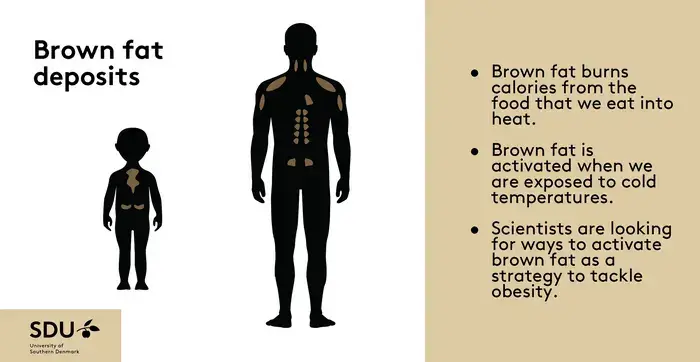ODENSE, Denmark — A cure for obesity may have been sitting in our fat all along. Scientists in Denmark have discovered a genetic “off switch” for the body’s brown fat — the substance that helps people burn calories. Knowing why brown fat stops working is now helping researchers come up with a way of activating it on command — which would help countless people lose excess weight.
Brown fat, also known as brown adipose tissue, is very different from the white fat that surrounds our bellies and thighs. This special tissue turns the calories we consume into heat, especially when it’s cold or weight loss patients are engaging in extreme activities, like winter swimming or cryotherapy. Scientists used to believe that only babies carried brown fat, but more recent research has shown that adults still retain some of their brown fat later in life. Unfortunately, humans hold on to less and less brown fat as they age.
The other problem has been finding out what quickly shuts off brown fat before it has a chance to really impact our weight during adulthood. With that in mind, researchers from the University of Southern Denmark and the University of Bonn in Germany examined the genetic mechanisms that turn brown fat on and off. That research uncovered the protein responsible for deactivating brown adipose tissue — AC3-AT.
Knowing how to turn brown fat off allows scientists to devise a way of keeping it on more often, helping people burn more fat and reach a healthy weight. In this study, the first step was removing the off switch altogether, so nothing could stop brown fat’s heat-producing abilities.
“Looking ahead, we think that finding ways to block AC3-AT could be a promising strategy for safely activating brown fat and tackling obesity and related health problems,” says Hande Topel, a senior postdoc in Prof. Jan-Wilhelm Kornfeld’s research group at SDU, in a media release.
“When we investigated mice that genetically didn’t have AC3-AT, we found that they were protected from becoming obese, partly because their bodies were simply better at burning off calories and were able to increase their metabolic rates through activating brown fat,” Topel reports.

In their experiments, the team followed two groups of mice that ate high-fat diets for 15 weeks — leading to obesity. One of those groups had their AC3-AT protein removed through genetic engineering. Results of the study, published in Nature Metabolism, show that mice without the brown fat off switch gained less weight despite eating fatty foods. These mice were also metabolically healthier than other mice still carrying the genetic switch.
“The mice that have no AC3-AT protein, also accumulated less fat in their body and increased their lean mass when compared to the control mice,” says study co-author Ronja Kardinal, a PhD student at the University of Bonn. “As AC3-AT is found not only in mice but also in humans and other species, there are direct therapeutic implications for humans.”
Although people lose much of their brown fat with age, it’s not impossible to activate this tissue and trigger weight loss. The easiest way to do it is by simply being cold. If you’re working out outdoors on a winter day, your body will turn on your brown fat, increasing metabolism. Scientists can now take these findings and work out the best way of silencing AC3-AT among obese patients and then exposing them to chilly environments which turn this calorie-burning fat on full-blast.
Along with discovering AC3-AT’s purpose, the researchers also note they found additional protein/gene versions of AC3, all of which respond to cold exposure just like AC3-AT. The team cautions that more research is still necessary to figure out the best way of transforming our brown fat into the newest weapon against obesity.

